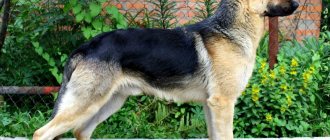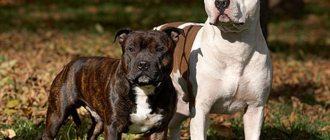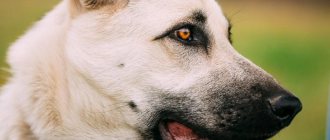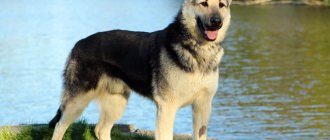Origin of rocks
The German Shepherd (HO) was bred at the end of the 19th century. from herding dogs in the lands of Scandinavia. In a short time she gained fame in Europe. In Germany, the breeding of such a dog has acquired a national scale. Selection was necessary to obtain ideal herding qualities and facilitate contact with people and other animals. When the number of pastures decreased, they were involved in the security forces.
The East European Shepherd (VEO) appeared thanks to the breeding work of the USSR at the beginning of the 20th century. When the need arose in the state for obedient dogs that could easily be trained, preference was given to the German Shepherd, which became the basis for a new species. Selection work began to breed more powerful and hardy shepherd dogs, capable of withstanding the climatic conditions of a large country. This breed was not recognized until 2002, considering it a subspecies of the German one.
Care
The puppy must learn the need for hygiene procedures. When he grows up, he will be calm about routine inspections, otherwise it will be difficult for the owner to cope with the large animal. Representatives of the breed require minimal grooming. Brushing is done daily only when shedding, which happens twice a year. The rest of the time, it is enough to remove dead hair with a rubber glove or brush 1-2 times a week. Bathing is carried out twice a month or as needed. In the summer, it is worth releasing the animal into the pond - the “eastern one” loves to swim.
Best articles: What species of animals are the largest on Earth - list, characteristics and photos
The ears of the East European Shepherd are subject to regular inspection. When a lot of brown plaque has accumulated in the sinks, it should be removed with a special lotion and a napkin. If you remove wax too often with a cotton swab, you can provoke even more secretion.
Dog breeders recommend not petting your dog for up to a year, since his ear cartilage is slowly and difficult to form and straighten: one careless movement can cause incorrect posture
Difference between Shepherds
Selection and places of residence led to the formation of a number of characteristics of each breed.
Differences in dogs are expressed both in character and in appearance.
By appearance
- Back. A typical difference between a German Shepherd and an Eastern European is the ridge line. It gently descends to the tail at an angle of 23°. The Easterner has no spinal tilt.
- Size. The Vostochnik is noticeably larger than the German.
- Limbs. In a free stance, the hind legs of the VEO are slightly laid back, while those of the German Shepherd are quite far.
By temperament
German Shepherds are energetic, sociable, drawn to people, express emotions clearly, and are easily excited. Enjoying physical activity, they cope with sports training brilliantly.
Eastern Europeans are serious, have a calm disposition and self-control. They can be incredibly stubborn. They are smart and easy to train.
According to characteristics and standards
Each officially registered breed has compliance standards. Parameters may vary depending on the country of breeding.
| BUT | VEO | |
| Height at withers/cm | 55-65 | 62-76 |
| Weight, kg | 22-40 | 30-60 |
| Back | Rolling | Rovnaya |
| Functions | Watchman, shepherd, bloodhound, participation in competitions | Guard, companion, guide |
| Color Black, zoned, black | Color Black, zoned, black | |
Veo or German, who to choose?
Both dogs are perfectly manageable with ideal service characteristics and behavior in general. Both have decent character, without excessive aggression, aimed at interacting with people.
Caring for both breeds is identical, including: proper and balanced nutrition, grooming, hygiene, physical activity, education and training, as well as a vaccination regime.
HO and VEO adapt well to different climatic conditions, but Eastern Europeans are more inclined to live in cold climates. They can live both in a house and in an apartment and in enclosure conditions.
Both pets require sufficient physical activity, a constant educational process, and a person with a strong character who can provide proper maintenance.
Types of colors
The following colors are found in both breeds:
- black-backed - a large dark area on the back in the shape of a mantle, descending to the elbows and sides and a mask on the muzzle;
- black is a rare color. Characterized by a solid coat color;
- zoned with tan marks – original color. The basis is a gray tone. A special feature is the ring coloring of the hair. The range of colors is varied.
Light and white wool, as well as plain red, is a defect in shepherd dogs. Such dogs are disqualified and not allowed to compete or breed.
How to distinguish from a mongrel?
Anyone can distinguish a purebred shepherd at 5 or 6 months from a mongrel, but not every buyer can do this at 1 or 2 months.
The main rules that will allow you to avoid being deceived:
- When purchasing, ask where the puppy’s parents are and ask to show them. Also find out what documents the parents have. To be 100% sure, you can call the Club and find out if these dogs are registered there;
- Puppies must be branded. The data on the stamp and in the metric must match;
- The puppy's eyes have an almond-shaped cut; when they turn their head, the white white is visible. Because of this, the eyes of the “German” are often compared to human ones;
- The iris can be from dark yellow to dark brown. The eyes may be blue for up to two months. Mutts have protruding, white, yellowish or speckled eyes.
- By the beginning of the shift, the shepherd dog should have 28 teeth. It is unacceptable for them to grow together or have an incorrect bite;
- The head of a purebred puppy should be proportional to the body. The forehead should not hang over the muzzle. There should be no beard between the eyebrows. The nose is black without a point. Lips in the color of your nose;
- Neck of medium length;
- The back is short and strong, the chest does not fall below the elbows;
- The tail should be long, it never rolls into a ring, and is always straight;
- The paws are large and large;
- The usual color of the German Shepherd is saddleback, but others are allowed. There may be a white martin on the chest, but spots inside it are not allowed;
- A purebred puppy will not be afraid of a person, but will try to follow any of his instructions - this is on a subconscious level. Mongrels avoid people. Also subconsciously.
Features of training
The East European Shepherd is reserved and serious. Classes are regarded rather as work that is done efficiently. Due to their mental stability, such dogs are taken for protection, as guide dogs, and for the border service. They only accept the owner and family members. They treat strangers with caution. Training can be done by a person of any age and level of training; it is not necessary to be a professional. But the breed is not very suitable for competitions. A phlegmatic character and an overly serious attitude towards exercise complicate the process. It will take much longer to achieve noticeable heights than with BUT.
For a German Shepherd, training looks like an entertaining game that brings delight. Training is easy. Such dogs are active, energetic, hardy, and capable of running long distances. But sometimes they play around and take the exercises lightly. They are choleric and love people. You can often see these dogs at competitions, because the German copes with even the most difficult training complex. Read more about training German Shepherds in this article.
Expert opinion
Anna Abramenko
An avid dog lover. Experience in veterinary medicine since 2009.
Ask a Question
The breeds are easy to train, but for competitions it is better to choose a German shepherd.
Other criteria
Activity
German Shepherds are much more active than the calmer Eastern European dogs, who are more interested in their immediate work than in participating in family games.
Trusting strangers
Representatives of both breeds are distrustful of strangers, but with proper upbringing they restrain themselves from showing aggression until they receive an order from the owner to attack.
Lifespan
East European Shepherds live 12-16 years, and the lifespan of a “German” is 10-14 years.
Devotion
Both breeds are distinguished by exceptional devotion to their owner. But the East European Shepherd is more likely to bond with one person, while the German will willingly work with anyone who gives him the opportunity to use his working skills.
Training
“German” treats training as a game, and “Eastern” - as real work, for which there should be encouragement.
What is the difference between a German puppy and an Eastern European one?
A characteristic feature by which puppies can be distinguished is the line of the back.
In the German Shepherd it is distinctly inclined towards the base of the tail. The second breed has an almost perfectly straight line between the withers and the croup.
When comparing a German Shepherd puppy with an Eastern European one, it is noticeable that the latter are born large and gain weight faster. They resemble elephants, slow and clumsy. The girth of their metacarpus is significantly wider.
In this table you can see the height and weight of a German by month.
general characteristics
Metis is the offspring obtained by crossing two or more breeds. Such offspring, as a rule, are superior to their parents in some respects. For example, it becomes stronger, more resilient, less susceptible to diseases, less aggressive, and so on. It is also characteristic of crossbreeds that they produce offspring both among themselves and with other breeds. Most often, the appearance of mestizos occurs as a result of human intervention, with purposeful experiments on animals.
The resulting dog has traits from both of its parents, but their combination often allows you to get even a new breed. Mixing of dog species can also occur randomly, especially with mongrels or those dogs that are outdoors without proper supervision.
Price of puppies
Factors that shape prices include:
- title of parents, purebredness;
- age and health;
- color and compliance with standards;
- city;
- availability of a set of documents for the dog;
- reputation of the nursery.
In Russia, you can buy a German shepherd from 5 to 650 thousand rubles. (on average 30-35 thousand).
An East European Shepherd costs less - 3-75 thousand rubles. (average price – 20-30 thousand).
Expert opinion
Anna Abramenko
An avid dog lover. Experience in veterinary medicine since 2009.
Ask a Question
When choosing a dog, you need to consider the purpose of the establishment. If it is for the protection of private property, for a campaign for a lonely person or for playing with a child, then the puppy can be taken without a pedigree, not in the capital’s nursery. This will have a good effect on the price.
If the plans include breeding, participation in exhibitions and competitions, then saving can only do harm.
Well-deserved success
When the breed was renamed Eastern European and made into an independent breed, the situation became completely confused: they did not find their own standards, and they had already abandoned the world ones. But the process has begun. First, a subtype of the German Shepherd appeared in our country. It later became a separate breed (officially named VEO in 1951).
Another Soviet line is considered to be the one that starts from a dog named Edi von Blumenduft. A little over eighty years ago (in 1935-1936) we received offspring from him and the daughters of the first Abrek. This offspring became the main, basic one. Son Fog had a classic color (black and tan) without shades, silver or brown spots. His descendant Kare was recognized as an all-Union leader in 1940, and in the first post-war year - a Moscow leader. Even during the years of the fight against fascism in the occupied areas, dogs were destroyed. The nursery of the People's Commissariat of Agriculture of the USSR, where the selection import was located, was empty. After the Victory, canine centers in Russia (Leningrad), Ukraine (Kyiv), Belarus (Minsk) and other cities started from scratch. The East European Shepherd has experienced a rebirth.
They worked in an integrated manner for almost half a century. The titanic work was crowned with success: a new East European type of shepherd dog was killed, noticeably different from the Western European one. The dogs looked large, well-built, strong, and muscular. They were distinguished by their harmonious build, dryness and muscularity. The first standard, which described the breed type in detail, was adopted in 1964, then it was changed more than once, supplemented, and divided into lines.
As for the coat, many are sure: long-haired East European Shepherds are nonsense, this does not happen. Indeed, the description of the axial hair indicates that it is straight and hard, reaches medium length, tightly lying, with a well-developed felt-like undercoat. The front limbs, ears, and head are covered with an even shorter “fur coat.” You can read as many descriptions of lines as you like - nowhere is such a feature officially recognized as “fleece from which you can weave braids.”
The place of breeds in the modern world
The German Shepherd is accepted by society and continues to gain popularity. Breeders all over the world maintain the quality of the breed at the highest level, so finding a purebred puppy that meets the standards is not difficult.
The East European Shepherd is less in demand. The Fédération Cynologique Internationale recognized the breed only in 2002. At a certain point, the population of the breed practically disappeared, but thanks to breeders and enthusiasts it was restored again. This species is distributed only in the CIS countries.
The opinion of dog handlers
The German Shepherd, from the point of view of dog handlers, is suitable for people who are partial to active leisure, long and frequent walks, and sports games. With good training, a German Shepherd puppy will grow into an excellent dog.
Those who live in a private home, need a watchdog, and lead a leisurely lifestyle should choose the Eastern European breed. A dog of this size will not be comfortable in a small apartment space. Lack of personal territory can lead to aggression towards people in close proximity.
Expert opinion
Anna Abramenko
An avid dog lover. Experience in veterinary medicine since 2009.
Ask a Question
The physical development of young individuals of this species occurs quickly and weight increases rapidly (this especially applies to East European Shepherds, which are larger from birth). Therefore, they are not recommended to jump over the barrier until they are fully mature.
Comparing the characteristics of the breeds, it becomes clear that the German Shepherd is suitable for active families with children and fans of sports competitions, while the Eastern European can become a faithful companion for a calm, balanced person or a guard for a suburban area. But the choice must be made based on your lifestyle and goals for getting a dog.
Character
Compared to its German counterpart, the Eastern European pet is more reasonable and phlegmatic. At rest, he does not show temper or harshness, but if the situation requires immediate action, the animal’s lightning-fast reaction will amaze everyone. In general, the pet does not like to show emotions aimlessly: it is serious and intends to serve for the benefit of its owner, therefore it performs best in guard and security service.
Distrust of strangers is firmly and ineradicably embedded in the character of the “Eastern woman”. She will not immediately attack every stranger, but as soon as danger arises, she will stand up for the owner
It is important that the animal knows how to behave adequately, so it is recommended to undergo OKD so that the dog can manage its emotions and protect the owner when it is really needed
“Eastern” males, when properly raised, do not compete with the owner for the right to be called a leader, and easily accept the role of a companion. But to do this, you need to show the puppy his place from the first day. If a dog senses a person’s spinelessness, it will not obey him.











